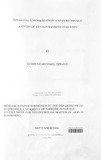| dc.description.abstract | This paper examines the empirical relationship between financial liberalization and bank
performance in Kenya. The paper also assesses and identifies the various factors 'that
explain commercial bank performance. Time series data covering the period 1973-2002
was analyzed. First, nature and characteristics of the data was assessed. Secondly the time
series characteristics of the data was assessed using unit root tests to examine the
stationarity of the variables used in the regression Besides the test for co-integration was
performed to determine the long-run relationship of the non-stationary variables. Lastly
estimation of the empirical model was done using the Ordinary Least Squares (OLS)
method.
The analyzed results show that financial liberalization impacted positively on bank
performance. There was an improvement in bank performance following financial
deregulation but further financial liberalization still needs to be undertaken Interest rate
spread widened following the reforms This indicates that the process of financial
liberalization was embarked on in an environment of high inflationary pressure,
distressed financial system coupled with fiscal indiscipline and fragile institutional
framework.
Based on these results, several policy implications are drawn that aim at improving the
performance of commercial banks for the benefit of the economy.
The rest of the paper is organized as follows. The first chapter of this paper provides
background information on financial liberalization .. and commercial banking in Kenya .
The chapter also traces the statement of the research problem, significance of the study,
hypothesis and finalizes with the objectives of the study. Chapter two constitutes the
review of all aspects of relevant literature while chapter three comprises the model
estimated in this study Chapter four zeros in on the data issues and empirical estimation
while the last chapter presents the conclusions, policy implications, areas of further
research and the lirnitations of study. | en |

